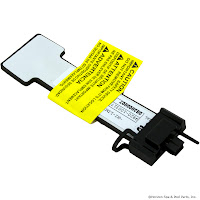Is there water leaking from the backwash/waste port on your pool filter valve?
If so, it is likely that you have a tear or a partially broken spider gasket.
This gasket is inside your pool valve and is what forms the seal between each port and the diverter plate.
Once there is a break in the seal water can leak into the surrounding ports, usually one will not notice until water leaks into the backwash or waste port as it is usually the only open/visible port.
These gaskets are used in both 'side mount' and 'top mount' Multi-Port Valves or MPV's and they are found in the valves used on sand and DE filters.
Variations, some MPV manufactures have a separate Spider Gasket/Diverter assembly where as others have the Spider gasket or similar seal molded into the diverter [See Below].
Why do spider gaskets break?
Typically with age, over or under use these gaskets will degrade require a replacement.
If you own a sand filter & are starting to change spider gaskets more often, it is likely you have larger problem associated with the laterals on the stand pipe. The laterals are the porous fingers on the bottom of the pipe running into the sand. Even small holes in the lateral will allow sand to enter the MPV body & as you continue using the valve sand will begin to damage the gasket.
How to replace a spider gasket?
Spider gasket replacement for Multiport Backwash Valves
1. Stop pump and release all pressure from system.
2. Place the selector handle at the "winterize" position ( this lifts the plug off the seat).
3. Remove the bolts and nuts holding the cover to the valve body.
Remove the cover assembly.
4. Remove the old gasket from the valve body.
5. Make sure that the gasket groove is free of water, grease, oils, debris and parts of the old gasket. Use alcohol to degrease.
6. NOTICE: Once this step is started, continue through Step 10 without interruption.
Using Loctite® 401, 403 and 416 apply glue sparingly (a bead about 1/16" wide)
to the bottom only (not the sides) of the spider groove in the valve body.
The glue lines must be continuous and intersect at the intersections of the grooves.
7. Insert the new gasket into the groove with the rounded bead up.
Press the gasket firmly into all groove areas to seat the new gasket evenly.
8. Align the tab on the cover assembly with pin on the valve body, fastening it with the bolts and nuts removed in Step 3. Tighten all bolts evenly.
9. Depress the valve handle and rotate it to the closest standard position (FILTER or RINSE), being careful not to rub the plug on the new gasket. Release the handle, allowing the plug to hold the gasket in place while curing.
10. Minimum cure time is 2 hours. Curing for 24 hours is recommended for full strength.












